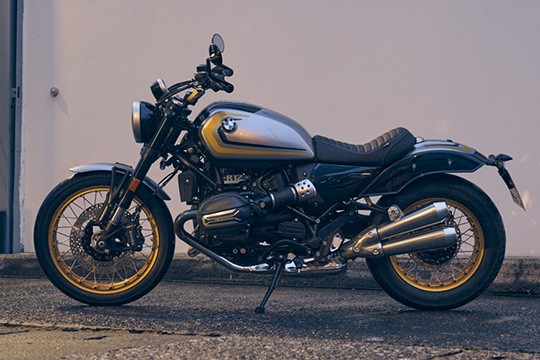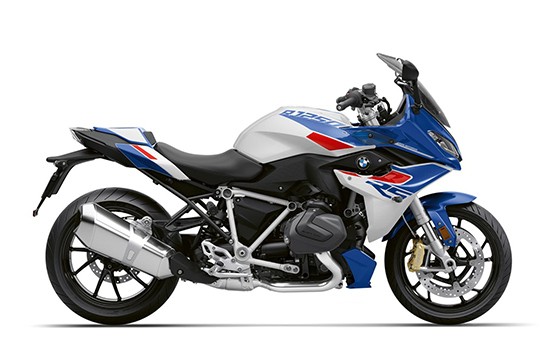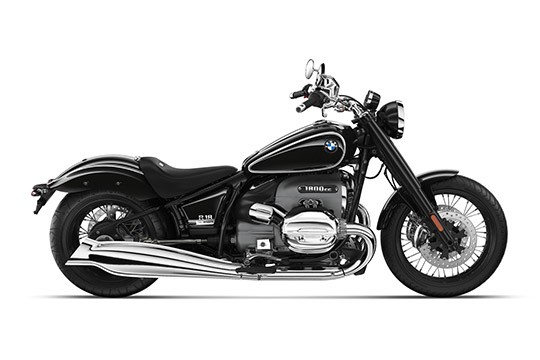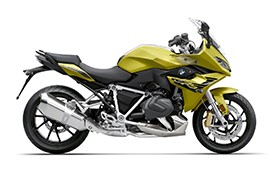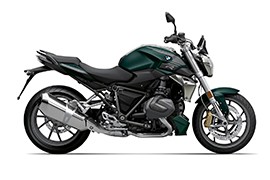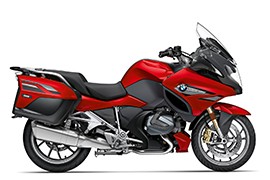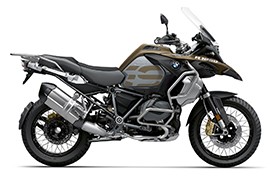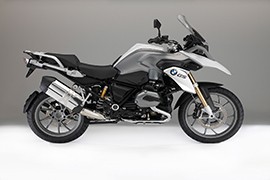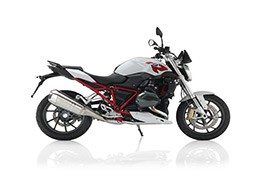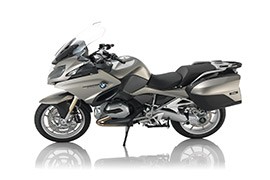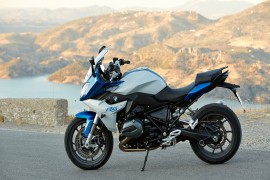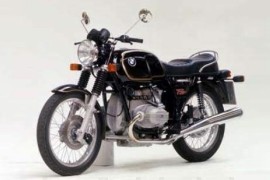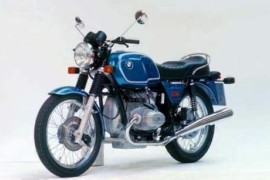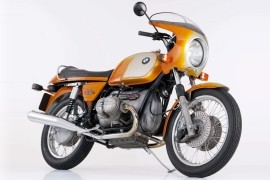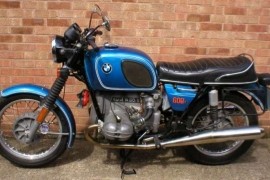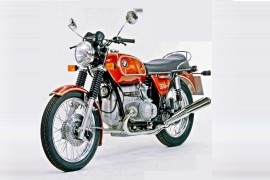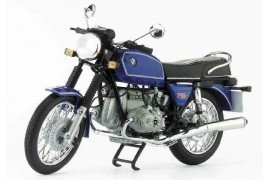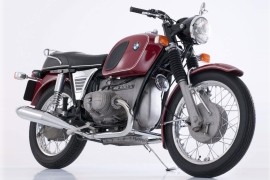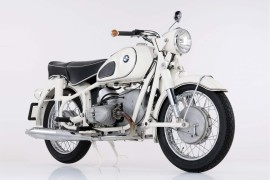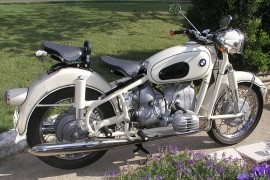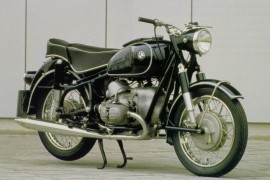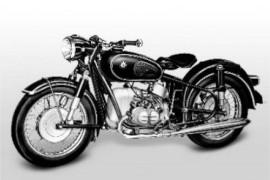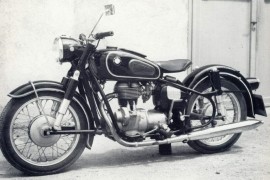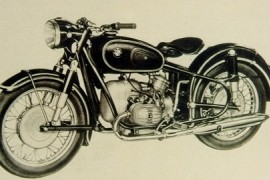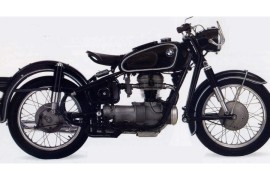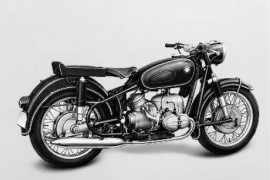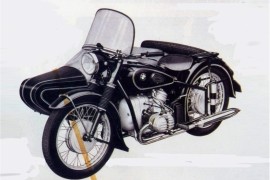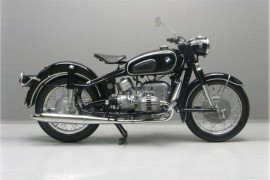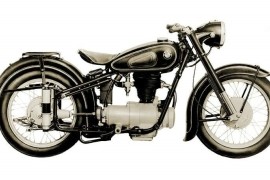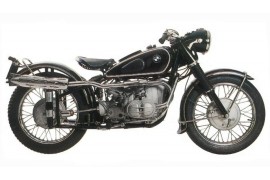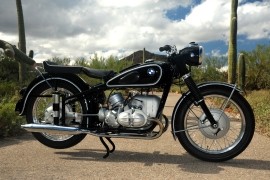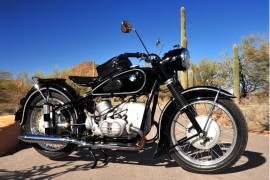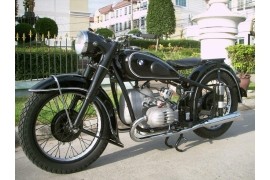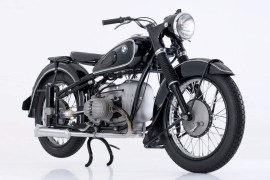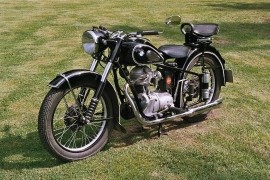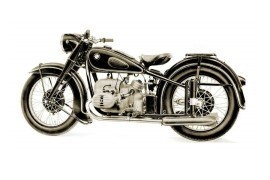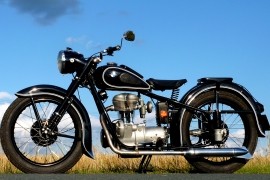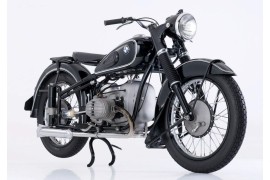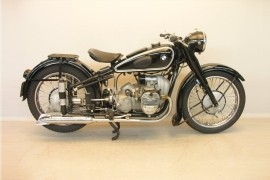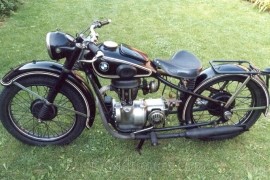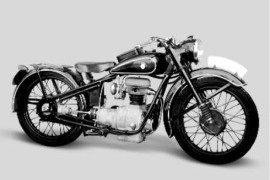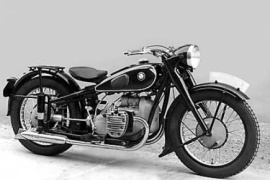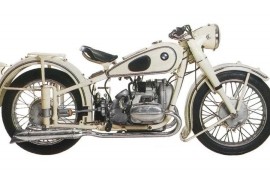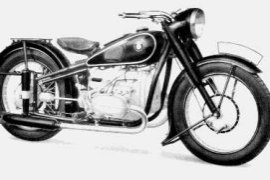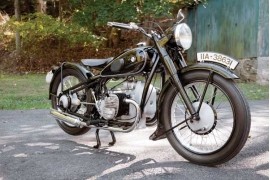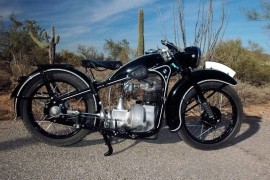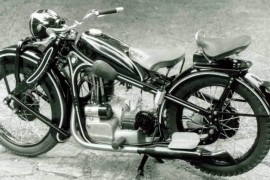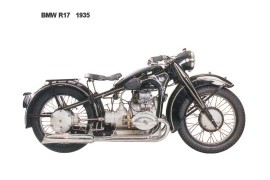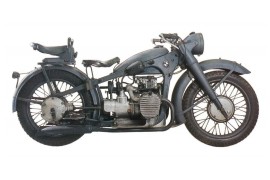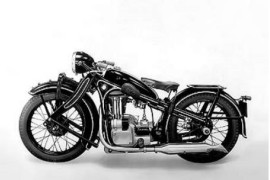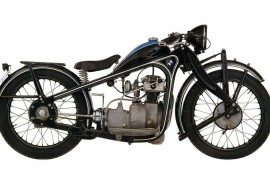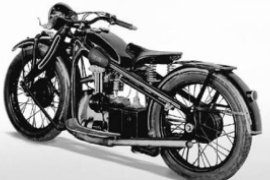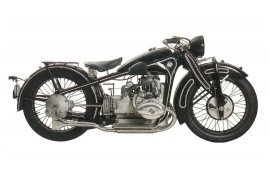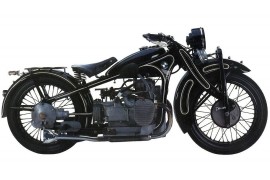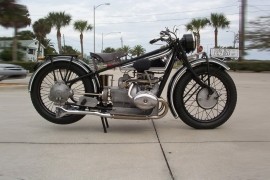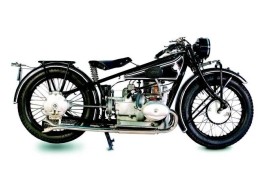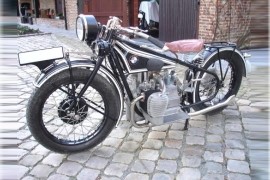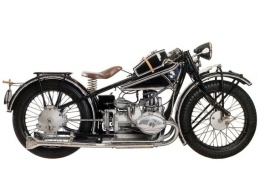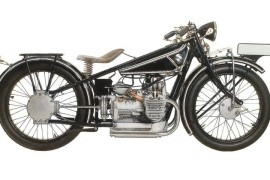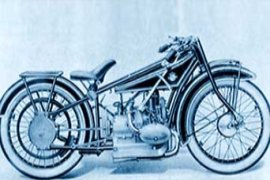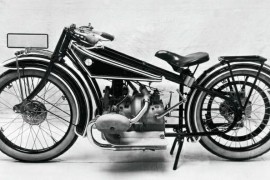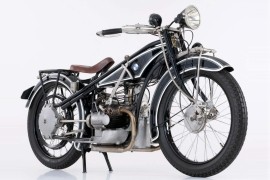BMW R Models/Series Timeline, Specifications & Photos
First production year: 1923
In 2023, the German motorcycle maker introduced the BMW R 12 alongside the R 12 nineT for the 2024 model year. The introduction of the original R nineT in 2013, which featured a classic design combined with modern technology, led to a whole range of Roadsters for the BMW Motorrad Heritage line.
Both models were built around a versatile chassis featuring a one-piece trellis frame, an airbox under the seat, and a rear shock absorber at an angle. This design allows for interchangeable fuel tank shapes, offering a better visual individuality.
The 2024 model year machine has three attractive color schemes, each giving the bike a high-end look. It is the Standard Blackstorm Metallic, Optional Aventurine Red Metallic, and Optional Option 719 "Thorium" in Avus Silver Metallic.
The 2024 model year BMW R 12 had its soul brought to life by a 1,170cc four-stroke two-cylinder liquid-cooled boxer engine managed by a fuel injection system, boasting 95 hp with a peak force at 6,500 rpm and 110 Nm (81 lb-ft) torque at 6,000 rpm.
The BMW R 12 is equipped with Dynamic Traction Control that provides high safety at hard throttle twists. In addition, it has Roll and Rock riding modes and comes with Engine Drag Torque Control as standard.
The 2024 BMW R 12 will be present with standard features, such as cast aluminum wheels, BMW Motorrad ABS, steering stabilizer, adjustable brake and clutch levers, keyless ride, onboard computer, USB-C connector, 12V power sockets, full LED lighting, and a steel tank.
The BMW R 1250 RS was a faired motorcycle part of the R series, first seen at the 2018 EICMA Motorcycle Show in November, and like other versions of the R series, such as the R 1250 RT, R1250 R, and R 1250 GS, the RS sport tourer was powered by a boxer engine.
The BMW RS was always a master of sporty riding and long-distance journeys, so to keep that reputation, BMW fitted the new 2023 R 1250 RS model with some standard features and optional extras that made sports touring even more dynamic and relaxed.
Like before, the legendary two-cylinder boxer engine offered powerful characteristics from its 1,254cc displacement that generated 100 hp at 7,250 rpm and 143 Nm (105 lb-ft) of torque available at 6,250 rpm thanks to its BMW ShiftCam technology, which provided beefy power across the entire speed range, smooth and quiet engine running, efficient fuel consumption, and low emission values.
The Dynamic Traction Control (DTC) and the new ECO driving mode came as standard features on the 2023 BMW R 1250 RS model, where the DTC ensured a high level of safety with excellent traction control.
As for the ECO mode, it allowed the rider to use the BMW Motorrad ShiftCam engine technology for maximum range and encouraged the rider to be as fuel-efficient as possible with soft throttle response and moderate engine torque limitation.
In addition, the bike came with standard features such as Dynamic Traction Control (DTC), BMW Motorrad ABS Pro, Dynamic Brake Control (DBC), ECO riding mode, and three riding modes.
The BMW R 18 is a cruiser motorcycle that started development in 2015 and was launched in September 2020 in Germany.
The R 18 missed an official launch at the BMW dealers due to the COVID-19 pandemic, so it was virtually presented over the internet. BMW had a first attempt to join the segment of heavy cruisers with the BMW R 1200C, which eventually led to the BMW R 18.
The R 18 is powered by e newly developed air and oil-cooled engine that is the largest two-cylinder boxer ever made for motorcycles by BMW. The R 18 engine has a capacity of 1,802cc and 90 hp (67 kW). The maximum speed that can be reached is a little over 179 kph (111 mph). It has an exposed prop shaft, and spoke wheels, and is scaled back to its core to be fully customized by the riders. Unlike the models that are equipped with carburetors, the BMW R 18 has digital engine management, an electronic fuel injection system, and electric throttle control.
It is equipped with a full-led headlight, and an automatic stability control system, but it also has three riding modes. Overall, the BMW R 18 is a cruiser with a lot of character, plus timeless design features, and could become a true rival for Harley-Davidson's legendary cruisers.
The BMW R1250RS was a faired motorcycle part of the R series in BMW's range, presented at the 2018 EICMA Show. Like other R version machines in the series, the R1250RS was powered by a boxer engine.
In 2018, the German motorcycle manufacturer launched the BMW R1250RS, a faired motorcycle that provided long-distance comfort. Unlike the R1250R, which offered minimal body coverage, the RS model had its body covered.
In the aesthetic department, the RS model had standard features, such as two LED headlights, a medium-sized windscreen, a two-piece dual seat with pillion grab rails, a two-into-one exhaust system, a single-sided swingarm, and 10-spoke lightweight wheels.
The bike was built on a two-section frame comprised of a main structure with a bolt-on rear frame, packing a 45 mm upside-down fork on the front and a single-sided aluminum swingarm with a BMW Motorrad Paralever unit on the rear, offering excellent handling capabilities.
In the braking performance, the machine packed two 320 mm floating brake discs with four-piston calipers on the front wheel and a 276 mm disc with a dual-piston caliper on the rear wheel, providing excellent stopping power.
As for the power figures, the 2018 BMW R1250RS had installed a 1,254cc four-stroke tow-cylinder air/liquid-cooled boxer engine that delivered an output power of 136 hp at 7,750 rpm and 142 Nm (105 lb-ft) torque at 6,250 rpm.
In 2018, the German motorcycle manufacturer launched the BMW R 1250 R, a naked motorcycle with high-end features and technologies. The new 2018 machine offered a more dynamic appearance and a new boxer engine.
The bike featured an optional Pro riding mode that unlocked two additional modes, Dynamic and Dynamic Pro, which were configurable. Also, it packed Dynamic Traction Control (DTC), a system that added a new level of safety when accelerating and braking.
The machine had standard features, such as a single headlight unit, a two-piece dual seat with passenger grab rails, a two-into-one exhaust system with an up-swept muffler, a single-sided swingarm, and lightweight 10-spoke wheels.
The bike's suspension system comprised a 45 mm upside-down telescopic fork on the front and a single-sided swingarm with an adjustable BMW Motorrad Paralever shock absorber on the rear, providing excellent suspension performance and handling.
As for the braking power, the wheels were fitted with two 320 mm discs with four-piston calipers on the front and a 276 mm disc with a dual-piston caliper on the rear wheel, providing excellent stopping power.
The 2018 BMW R1250R had installed underneath its fuel tank a 1,254cc four-stroke two-cylinder air/liquid-cooled boxer engine fed by a fuel injection system, boasting 136 hp at 7,750 rpm and 142 Nm (105 lb-ft) torque at 6,250 rpm.
In 2018, the German motorcycle manufacturer launched the BMW R 1250 RT, a motorcycle with a new look, more standard equipment, and various technical upgrades for a better unique riding experience.
The bike was fitted with Dynamic Traction Control (DTC) that ensured a high level of safety with excellent traction control and a new ECO riding mode that helped the rider achieve better fuel efficiency.
Some of the bike's highlights were represented by a new BMW Motorrad Full Integral ABS Pro as standard, three riding modes, Dynamic Electronic Suspension Adjustment (ESA), Hil Start Control Pro (HSC Pro), new aerodynamic front fairings, LED Headlight and taillight, and a new 2.0 audio system.
In the aesthetic department, the motorcycle had standard features, such as a full fairing with a medium-sized windscreen, a two-piece dual seat with passenger grab handles, a small luggage rack, side-mounted panniers, a single-sided swingarm, and 10-spoke lightweight wheels.
In the performance department, the 2018 BMW R1250RT had its soul brought to life by a 1,254cc four-stroke two-cylinder air/liquid-cooled engine with a fuel injection system in charge, delivering 136 hp at 7,750 rpm and 142 Nm (105 lb-ft) torque at 6,250 rpm.
The bike's power was delivered to a six-speed manual transmission with a wet multi-plate clutch, spinning the rear wheel through a final chain drive.
In 2018, the German motorcycle manufacturer launched the BMW R1200GS, a standard naked machine that had more power and torque on board than its predecessor but also with improved emissions and fuel economy.
The BMW R1200GS was a naked motorcycle that debuted in 2004, manufactured at BMW's plant in Berlin, Germany. The bike was part of the BMW Group and was powered by a 1,170cc boxer engine.
The 2018 motorcycle was fitted with standard features, such as a front mudguard, an upper fairing with an extended fender, a small windscreen, a two-piece dual seat with passenger grab rails and a small luggage rack, a single-sided swingarm, and lightweight 10-spoke wheels.
For the first time, BMW's ShiftCam technology has been used in a BMW motorcycle. The system enabled the variation of the valve timing and the valve stroke on the intake side. As optional, the bike was available with a Pro riding mode that featured three additional riding modes, including the Enduro Pro model of the R1200GS Adventure model.
In the performance department, the 2018 BMW R1200GS had installed underneath its fuel tank a 1,254cc four-stroke air/liquid-cooled two-cylinder engine that delivered an output power of 136 hp at 7,750 rpm and 142 Nm (105 lb-ft) torque at 6,250 rpm.
The bike's power was handled by a six-speed manual transmission with a wet multi-disc clutch that spun the rear wheel through a final chain drive.
The BMW R1200GS alongside the R1200GS Adventure were two dual sport motorcycles manufactured by BMW in Berlin, Germany. The bikes shared the same 1,170cc twin-cylinder boxer engine, different-capacity fuel tanks, and suspension travel.
In 2017, the German motorcycle manufacturer launched the BMW R1200GS, which received a facelift and other modifications. The bike was made to meet EURO4 regulations and received an onboard computer, side reflectors, and diagnostic lights in the cockpit.
In the visual department, the motorcycle was fitted with standard features, such as an upper fairing with an extended fender, a two-piece dual seat with pillion grab rails, a two-into-one exhaust system with a large up-swept muffler, lightweight 10-spoke wheels, and a center stand.
Underneath its fuel tank, the 2017 BMW R1200GS had installed a 1,170cc four-stroke twin-cylinder liquid-cooled boxer engine fed by an electronically controlled fuel injection system, delivering 125 hp at 7,750 rpm and 125 Nm (92 lb-ft) torque at 6,500 rpm.
In the suspension department, the bike packed a 37 mm BMW Motorrad Telelever unit on the front and a single-sided aluminum swingarm with a BMW Motorrad Paralever unit on the rear, providing excellent handling capabilities.
As for braking performance, the motorcycle packed two 320 mm discs with four-piston calipers on the front wheel and a 265 mm disc with a single-piston caliper on the rear wheel, offering excellent stopping power.
The BMW 1200R was a standard machine introduced by BMW Motorrad in 2006 as a replacement for the BMW R1150R and continued production until 2018 when it was replaced by the BMW R1250R.
Compared to its predecessor, the BMW R1200R came in a lighter package, losing 25 kg (55 lbs) and a 28 percent power increase. In 2015, the maker introduced a completely redesigned model that packed the same engine as the 2014-2015 R1200RT in a lighter package.
In 2016, the German motorcycle manufacturer launched the BMW R1200R, a naked machine fitted with the latest technologies. It packed standard features, such as a two-piece seat with a passenger grab handle, an engine spoiler, a side stand, and 10-spoke lightweight aluminum wheels.
The bike was built on a tubular steel bridge-type frame with a 45 mm upside-down telescopic fork on the front and a single-sided swingarm with a BMW EVO Paralever shock absorber on the rear, providing excellent handling capabilities.
In the braking department, the bike's wheels were fitted with two 320 mm floating discs coupled to four-piston calipers on the front and a 276 mm disc squeezed by a dual-piston floating caliper on the rear, offering excellent stopping power.
As for the power figures, the 2016 BMW R1200R had its heartbeat set by a 1,170cc four-stroke liquid-cooled flat-twin boxer engine that delivered 125 hp at 7,750 rpm and 125 Nm (92 lb-ft) torque at 6,500 rpm.
The BMW R1200RT was a touring or sport-touring machine created by the House of Munich from 2004 to 2019 as a replacement vehicle for the BMW R1150RT model. The bike was powered by a 1,10cc flat twin engine and set in motion by a six-speed transmission with a final shaft drive.
In 2014, the German company introduced a redesigned BMW R1200RT with several modifications. The largest one was integrating a liquid-cooled system, followed by minor updates, such as the seating position, fairing, instruments, and frame.
Standard features included two ride modes, Rain and Road, which were activated at the press of a button for various road conditions, an onboard computer, an electrically adjustable windscreen, color-matched panniers, and heated grips.
In 2016, the German motorcycle manufacturer launched the BMW R1200RT, a sport-touring motorcycle packed with standard features, such as an upper fairing with a medium-sized windscreen, a two-piece dual seat with passenger grab rails, side-mounted panniers, a side stand, and lightweight 10-spoke aluminum wheels.
As for the power figures, the 2016 BMW R1200RT had its soul brought to life by a 1,170cc four-stroke twin-cylinder liquid-cooled boxer engine fed by an Electronic Fuel Injection (EFI) system, delivering 125 hp at 7,750 rpm and 125 Nm (92 lb-ft) torque at 6,500 rpm.
The bike's suspension system comprised a 37 mm BMW Telelever fork on the front and a single-sided swingarm with an adjustable BMW EVO Paralever shock absorber on the rear, delivering excellent suspension performance and handling.
The BMW R1200RS was a sport-touring motorcycle made by BMW Motorrad from 2015 to 2018. It was presented at the 2014 Intermot Show and was based on the BMW R1200R. Also, the machine was equipped with a boxer engine, assembled at BMW's plant in Berlin.
The bike's production began on February 9, 2015, and was released into the world of motorcycling on May 12, 2015. When first launched, the bike had an MSRP of $14,400. In 2019, the BMW R1200RS was replaced by the BMW R1250RS.
In 2016, the German motorcycle manufacturer launched the BMW R1200RS, a sport-touring machine that blended the two worlds in a modern concept. The bike offered a relaxed but sporty seating position and impressive wind and weather protection.
In the aesthetic department, the bike was fitted with standard features, such as a front aerodynamic upper fairing, a medium-sized windscreen, a two-piece dual seat with passenger grab rails, a side stand, and 10-spoke lightweight wheels.
Underneath its fuel tank, the 2016 BMW R1200RS had installed a powerful 1,170cc four-stroke liquid-cooled flat twin engine with an electronically-controlled fuel injection and ride-by-wire systems. As for the power figures, the bike boasted 125 hp at 7,750 rpm and 125 Nm (92 lb-ft) torque at 6,500 rpm.
The bike was built on a tubular steel bridge-type frame with a 45 mm upside-down telescopic fork on the front and a single-sided swingarm with an adjustable single shock absorber, offering excellent handling capabilities.
In 1976, BMW marketed once again a traditional 750cc model with the launch of the modified /7 series. The newly released BMW R 75/7 was fitted with a new 24-liter tank with the new recessed safety tank filler pipe and a new front wheel mudguard, just like its smaller R 60/7 sister model.
The only difference between R 75/7 and its little sister, was made by the Bing carburetors and a brakes disc mounted on the front wheel. The engine of the model was carried away from its predecessor but optimized for noise reduction.
The previous series was considered very robust and mature, so the R 75/7 did not receive any significant changes or innovations to the manual transmission or chassis.
Onto the double loop frame with a bolted rear section took its place the 745cc flat-twin engine that developed a power output of 50 hp at 6,200 rpm and 58 Nm and 58 Nm (43 lb-ft) of torque available at 5,000 rpm. In conjunction with the curb weight of 215 kg (474 lbs), the power from the engine pushed the bike to a top speed of 177 kph (110 mph).
For stopping power, the 1976 BMW R 75/7 had packed on the front wheel a 260 mm single disc brake and a 200 mm drum unit on the rear wheel.
In 1976, BMW released the R 60/7, a motorcycle that received some details improvements and modifications. The 24-litter tank, which was only available on the R 90 S, was also fitted on the R 60/7 model.
The fuel cap was fitted with a roll-over valve that prevented the fuel from spilling out in case of an accident. Also, the bike received a tank bag, an accessory that was popular at the time.
The bike was fitted as standard with perforated disc brakes on the front, and on the engine side, it kept the same performance as its predecessor, but changes were made in the inside of the engine to reduce the noise that came from the valve train.
The 1976 BMW R 60/7 powered by a 599cc flat-twin engine with a power output of 40 hp at 6,400 rpm and 49 Nm (36 lb-ft) of torque, enjoyed good sales because was primarily ordered by the government agencies that were loyal to BMW Motorrad.
The model featured modern brakes on the front, with a single perforated disc and a simplex drum unit mounted on the rear wheel.
The model came with standard features such as wire-spoked wheels, a dual seat with passenger grab rails, a dual chromed exhaust system, an analog instrument cluster, a large round headlamp, and a black-finished steel frame.
In 1973, BMW released the R 90 S model as the flagship model of the revised /6 series and ranked among the fastest series motorcycles in the world with a top speed of 200 kph (124 mph). This was possible due to the 67 hp achieved by boosting the two-cylinder boxer engine to 900cc and with the help of Dell’orto carburetors.
To keep the high performance under control, BMW fitted the bike with a double disc brake system on the front wheel, which was a first on the motorcycle market.
For this model, BMW hired for the first time a designer which created a profile for the bike that set it apart from other motorcycles in the market with the world’s first cockpit fairing attached to the handlebar, a tank designed with flowing contours, and a characteristic bench seat.
In 1975, BMW introduced a new livery for the bike with the Daytona Orange that became a favorite among collectors.
The 1973 BMW R 90 S featured an 898cc air-cooled four-stroke two-cylinder boxer engine with a power output of 67 hp at 7,000 rpm and 76 Nm (56 lb-ft) of torque at 5,000 rpm.
The bike came with standard features such as a dual seat, a pillion grab rail, a nose-fairing with a windscreen, a dual exhaust system, an analog instrumentation panel, wire-spoked wheels, and a side stand.
In 1973, BMW launched the R 60/6 model that replaced the R 50/5 as the entry-level model, and to keep the price down, BMW retained the drum braking unit on the front wheel and the slide carburetor that controlled the fuel supply.
The 1973 BMW R 60/6 featured innovations such as a five-speed transmission, a new instrument cluster with a side-by-side speedometer and tachometer, and new handlebar controls. The bike lacked success in the marketplace, but thanks to private customers and the loyal government agencies that were supplied by the BMW range, more than 13,000 units were sold.
The R 60/6 model had at its core a 599cc air-cooled, four-stroke, twin-cylinder boxer engine with an output power of 40 hp available at 6,400 rpm and 49 Nm (36 lb-ft) of torque at 5,000 rpm, and with the help of the five-speed manual transmission, the bike reached a top speed of 167 kph (102 mph).
For braking, the model packed a 200 mm duplex drum unit on the front and a simplex drum unit on the rear.
For smooth riding, the bike featured a telescopic fork with hydraulic shock absorbers on the front wheel and along swingarm with adjustable shock absorbers on the rear wheel.
As standard features, the bike came with wire-spoked wheels, a dual seat, pillion grab rails, a small taillamp, a round headlamp, an analog instrumentation panel, a dual exhaust system, and a center stand.
In 1973, BMW launched the revised /6 series that marketed two models in the 900cc class. One was the R 90 S, a sports model, and the other was the R 90/6, a high-torque tourer that appealed to enthusiasts of long-distance trips.
The R 90/6 model was the first motorcycle in the world equipped with H4 light as standard, which in conjunction with the large 200 mm round headlight, resulted in excellent light output. The 1973 BMW R 90/6 featured more success shown by the sales numbers, which were around 3,600 units more than the sportier model.
The R 90/6 motorcycle had at its core an 898cc air-cooled, four-stroke, two-cylinder boxer engine that provided an output power of 60 hp at 6,500 rpm and a maximum top speed of 188 kph (115 mph).
For suspension, the bike had a telescopic fork with hydraulic shock absorbers on the front wheel and a long swingarm with adjustable shock absorbers on the rear wheel.
For braking purposes, the model featured a 260 mm disc on the front and a 200 mm simplex drum unit on the rear.
In addition, the bike came with standard features such as a dual seat with pillion grab rails, a large round headlight, wire-spoked wheels, a dual exhaust system, and an analog instrument cluster.
In 1973, BMW replaced the R 75/5 model with the R 75/6 motorcycle, which featured a large number of innovations, such as disc brakes on the front wheel and new five-speed transmission. The bike was considered a modern and advanced motorcycle at the time.
The 1973 BMW R 75/6 model adopted the maintenance measures introduced in the last year of production of the /5 series, such as the rear wheel swingarm extended by 50 mm that improved the driving stability at high speeds and when used with a passenger and luggage.
At the core of the model was a 745cc air-cooled four-stroke twin-cylinder boxer engine with a power output of 50 hp available at 6,200 rpm. With a curb weight of 210 kg (463 lbs), the bike hit a top speed of 177 kph (109 mph).
For better braking, on the front wheel was mounted a 260 mm single brake disc and a 200 mm simplex drum unit on the rear.
For suspension, the bike packed a telescopic fork with hydraulic shock absorbers on the front wheel and a long swingarm with adjustable shock absorbers on the rear wheel.
The bike came with standard features such as wire-spoke wheels, a dual exhaust system, a center stand, a large headlamp, a dual seat, pillion grab rails, and an analog instrumentation panel.
BMW relocated the motorcycle production to Berlin because the Munich plant needed to expand its capacity for car production. In 1969 in Berlin, BMW started the production of the /5 series with the R 60/5, R 75/5, and R 50/5 models.
The bigger models, such as the R 60/5 and R 75/5, exceeded all expectations with their performance and price joined in a favorable combination. The combination of the performance and price also attracted government agencies like police forces which were tough customers. Even the BMW management was surprised by the success of the models, which recorded 4,701 units sold until the end of 1969 and 12,287 units sold in 1970.
Overall, the BMW R60/5 was a well-balanced middle-class motorcycle with attractive performance and a matching sales price. The model had at its core a 599cc flat-twin engine with a power output of 40 hp at 6,400 rpm that could push the bike to a maximum top speed of 167 kph (102 mph).
Onto the double-loop steel frame, the model featured a telescopic fork with a hydraulic damper on the front and a long swingarm with spring legs on the rear acting as suspension. The stopping power was handled by a 200 mm duplex hub unit on the front and a simplex hub unit on the rear.
The 1969 BMW R 60/5 rolled off the production line with standard features such as a dual seat, passenger grab rails, a dual exhaust system, a side stand, wire-spoked wheels, a large headlight, and a large 24-liter (6.3-gallon) fuel tank.
In the mid-1960s, motorcycles were no longer seen as transport vehicles, as much as were considered leisure vehicles. It was a perfect opportunity for BMW, which presented a newly developed model range that included the R 50/5, R 60/5, and R 75/5 and offered numerous innovations.
The R 50/5 model featured a double-loop frame with a bolted rear part, a long-stroke telescopic fork on the front, and a swingarm on the rear. A revolutionary feature offered as optional for the 1969 R 50/5 model was the electric starter and standard on the larger R 60/5 and R 75/5 models.
Apart from the construction principle of an air-cooled two-cylinder boxer unit, the engine was also a new design and had nothing in common with its predecessors.
The flat-twin engine mounted on the R 50/5 with a displacement of 498cc had an output power of 32 hp available at 6,400 rpm. With a curb weight of 205 kg (452 lbs), the bike registered a top speed of 157 kph (96 mph).
For stopping power, the model featured drum braking units with a 200 mm duplex drum unit on the front and a simplex drum unit on the rear.
In all other departments, the 1969 BMW R 50/5 model had the same standard features, such as wire-spoked wheels, an analog instrument cluster, full fenders, a dual exhaust system, a round headlamp, a small taillight, and a center stand.
In 1969, as the motorcycle market was going in decline, BMW launched a new model series. There were the right conditions for a change in trend with the customers demanding performance, and the motorcycle was no longer seen as a basic transport vehicle, but as a sport and leisure vehicle.
The 1969 BMW R 75/5 was part of the presented series that impressed with good performance, safe driving characteristics, and a high level of reliability. The model lagged behind most important motorcycle manufacturers with its performance specifications, but BMW provided problem-free driveability, which was more important in everyday use.
The model had the same top speed as its predecessor but outperformed it by more than one second in acceleration from 0-100 kph (0-60 mph) and by three seconds in the sprint to 140 kph (87 mph).
In the power department, the R 75/5 model featured a 745cc flat-twin engine with an output power of 50 hp available at 6,200 rpm. With a curb weight of 210 kg (463 lbs), the bike reached a top speed of 175 kph (107 mph).
Standard features that came with the bike included wire-spoked wheels, a dual exhaust system, a dual seat, a small luggage rack in the rear, pillion grab rails, a large headlamp, full fenders, and a side stand.
While the German motorcycle industry was at the ground in the 1960s, BMW set a benchmark with the release of the R 69 S, which was the fastest German motorcycle at the time. Even in the international market, a small number of motorcycles could achieve the maximum top speed of 175 kph, which the BMW R 69 S succeeded to achieve.
The switchable steering damper was a new feature of the model that, in conjunction with the tried and tested full-swing chassis, gave the bike high directional stability even at higher speeds.
To set the motorcycle apart from the touring models, the white paint job and double seat, which were available only for government agencies, were released to the public as well.
The 1960 BMW R 69 S was the successor of the R 69 model and packed a 594cc flat-twin engine that developed seven hp more than its predecessor. With a power output of 42 hp available at 7,000 rpm and a curb weight of 198 kg (436 lbs), the model reached a top speed of 175 kph (109 mph).
The motorcycle featured a long swingarm with spring struts and oil dampers both on the front and rear that acted as suspension and as brakes, it had a 200 mm duplex full hub drum unit on the front and a 200 mm simplex full hub drum unit on the rear.
The bike came with standard features such as full fenders, a dual exhaust system with pea-shooter mufflers, a large headlight, wire-spoked wheels, and an analog speedometer.
In 1960, at the IFMA (International Bicycle and Motorcycle Exhibition) in Cologne, the mood was not quite good because many motorcycle manufacturers filed for bankruptcy while others were trying to survive.
The BMW motorcycle manufacturer also got hit by the crisis, which was seen in the annual production figures that have fallen from almost 30,000 to a little higher than 8,000.
At the exhibition, BMW presented two slightly modified touring models, the R 50/2 and R 60/2, which replaced the previous models, R 50 and R 60. The released touring models remained in the BMW range until the end of production in 1969.
The 1960 BMW R 60/2 replaced the R 60, which was a popular motorcycle primarily used in a sidecar combination. The /2 designation was used internally while the public continued to sell the model as an R 60.
The model presented at the exhibition packed a 594cc flat-twin engine with a power output of 30 hp at 5,800 rpm, two more than its predecessor, and registered a top speed of 145 kph (89 mph).
The bike came with standard features such as a dual exhaust system, a large headlamp, wire-spoked wheels, a center stand, long fenders, a rear luggage rack, and a small taillight that tipped the scale at 195 kg (430 lbs).
Despite declining sales figures recorded by BMW in the mid-1950s, at the International Bicycle and Motorcycle Exhibition in Cologne, BMW presented a revised model range with the spotlight on the R 69 S that had a top speed of 175 kph (109 mph).
Also presented at the exhibition was the slightly modified R 50/2 that replaced the successful R 50 touring machine. Until 1969, when production of the R 50/2 came to an end, it was the most successful full-swing model, with more than 19,000 units sold.
The 1960 BMW R 50/2 motorcycle was taking its power from the 494cc flat-twin engine with a power output of 26 hp available at 5,800 rpm. The bike tipped the scale with a curb weight of 202 kg (445 lbs), and with the original BMW sidecar attached at 320 kg (705 lbs). The model had a top speed of 140 kph (86 mph).
Onto the double-cradle steel frame, the bike featured a long swingarm with spring struts and oil pressure dampers suspension on the front and rear. The stopping power was handled by a duplex full hub drum unit on the front wheel and a simplex full hub drum unit on the rear wheel.
It came with standard features such as wire-spoked wheels, an analog instrument cluster, full fenders, a dual exhaust system, a large headlamp, a small taillight, and a center stand.
Due to the crisis that went on in the 1950s, many motorcycle manufacturers had to file for bankruptcy in recent years, and others were trying to survive. Even BMW was left with a mark, which from 1954 to 1959 the annual production figures went from 30,000 to a little over 8,000 units manufactured.
In 1960, at the Frankfurt International Bicycle and Motorcycle Exhibition, BMW released the R 50 S alongside a revised product range. The R 50 S was the first sporty motorcycle in the 500cc class manufactured after the war.
But unfortunately, the R 69 S was a better choice for ambitious customers due to its bigger engine capacity and stronger power output than the BMW R 50 S. The model did not have a big success and was discontinued after two years with only 1,634 units manufactured.
The 1960 BMW R 50 S had a 494cc flat-twin engine at its core with a power output of 35 hp at 7,650 rpm. With a curb weight of 195 kg (430 lbs), the bike had a top speed of 160 kph (100 mph). With the original BMW sidecar attached, the overall weight was 320 kg (705 lbs).
The bike came with standard features such as a single seat, wire-spoked wheels, a large headlamp, full fenders, and mid-mounted footpegs.
In 1960, at the International Bicycle and Motorcycle Exhibition Show in Cologne, BMW presented the R 50 and 69 S models as a completely revised model range, and the R 27 model was presented for the first time to the public as a new release.
Like its predecessor, the R 27 model featured a full-swing chassis but with a new update. The engine was supported onto the frame by four rubber mounts that provided smooth-running characteristics and set benchmarks for single-cylinder engine constructions.
The R 27 models feature was presented as a floating engine and kept in place a 247cc single-cylinder engine with a power output of 18 hp at 7,400 rpm. With a curb weight of 162 kg (357 lbs), the bike was registered with a top speed of 130 kph (80 mph).
In the braking department, the model featured a 160 mm full hub drum unit both on the front and rear wheels.
Standard features that came with the bike included a single seat, wire-spoked wheels, an exhaust system with a large muffler, a large headlamp, and full fenders.
The production of the R 27 model was discontinued after 15,364 units were manufactured. BMW did not release any successor for the model until 1993 when a BMW single-cylinder bike rolled out of the manufacturing plant.
The first two motorcycles that featured a full-swing chassis were the R 50 and R 69, released by BMW in 1955. In 1956, in the 600cc series, BMW introduced the R 60, a touring motorcycle that rounded the BMW range and replaced the R 67 sidecar model.
Compared to its predecessor, the engine remained with the same characteristics and provided sufficient power and torque to be used in a sidecar combination. The key innovation of the R 60 model was the full-swing chassis, which instead of the plunger telescopic suspension, the model used a long swingarm that guided the wheel on the rear and on the front featured a slidable swingarm.
An important thing that helped BMW survive in the 1950s and 1960s was the popularity of the R 60 used in a sidecar combination by police forces around the world, so selling to the authorities became an important pillar for BMW in the motorcycle business.
The 1956 BMW R 60 model featured a 594cc flat-twin engine that developed a power output of 28 hp with a peak at 5,600 rpm. With a curb weight of 195 kg (430 lbs), the bike reached a top speed of 145 kph (89 mph).
The model came with standard features such as a single seat, a large headlamp, wire-spoked wheels, large fenders, and a dual exhaust system.
The BMW R 25/3, with a production run of 47,000 units, was the most successful motorcycle in the BMW range. In 1956, with a new full-swing chassis like the one introduced in previous years, BMW released the R 26 model as a successor to the R 25/3 model.
The benefit of the new chassis consisted of more adjustment options for the drivers, such as the caster of the front wheel could be individually adjusted for solo and trailed operations.
Due to the growing motorcycle crisis in Germany at the time, the R 26 model, despite the sophisticated technology, could not match the success of the R 25 motorcycle.
The 1956 BMW R 26 model had its heartbeat set by a 247cc single-cylinder engine with an increased output power to 15 hp available at 6,400 rpm, which increased the top speed to 128 kph (80 mph) and made the R 26 the fastest model in the 250cc series at the time.
The model featured a welded double-loop tubular steel frame, a long swingarm with spring struts, oil pressure shock absorbers both front and rear acting as suspension, and a 160 mm full hub drum unit both front and rear which provided the stopping power needed.
As standard features, the bike came with wire-spoked wheels, full fenders, a single-sprung seat, and an exhaust system with a large-diameter muffler.
In 1955, BMW released the first models with a full-swing chassis that replaced the old plunger suspension. The BMW R 50 and R69 featured a rear wheel mounted in a long swingarm with the cardan shaft encapsulated in the right-hand swingarm and a shifted swingarm on the front.
The chassis provided great stability in all driving situations, either solo or trailed operations. The R69 model, considered a sports model, was also popular with police forces which helped BMW survive in the 1950s and 1960s.
The R69 model retained the engine from its predecessor almost unchanged and provided enough power for sporty drivers to enjoy. Like its predecessor, the 1955 BMW R69 broke the 100-mile limit with a top speed of over 160 kph.
In the power department, the 594cc flat-twin engine had a power output of 35 hp with a peak at 6,800 rpm and pushed the bike to a top speed of 165 kph (102 mph).
A 200 mm duplex full hub drum unit on the front and a 200 mm simplex full hub drum unit on the rear were there to ensure the stopping power needed.
Standard features that came with the bike such as wire-spoked wheels, a dual exhaust system with pea-shooter mufflers, a dual seat, a small tail-light, a round headlight, a center stand, a black-finished steel frame, and full fenders, tipped the scale at 202 kg (445 lbs) and with the sidecar attached at 320 kg (705 lbs).
In 1955, when BMW released the new swing-arm models, R 50 and R 69, the R 67/3 was the only model in the BMW range with a plunger suspension. The model was available only in a sidecar combination and didn’t feature any significant modification compared with its predecessor.
The plunger suspension chassis that defined the BMW profile since 1938 was let go along with the discontinued R 67/3 model in 1956, and in just one year of production, 700 units of the R 67/3 model got to see the daylight.
The 1955 BMW R 67/3 had a 564cc flat-twin engine with a power output of 28 hp available at 5,600 rpm. With a curb weight of 192 kg (423 lbs) and 320 kg (705 lbs) with an original sidecar attached, the R 67/3 model had a top speed of 145 kph (89 mph).
The model featured a double cradle tubular steel frame with a telescopic suspension both front and rear, a 200 mm duplex full hub drum unit on the front, and a 200 mm simplex full hub drum unit on the rear, as brakes.
The R 67/3 model came with standard features such as a sidecar, a large headlamp, a spare wheel mounted on the back of the sidecar, wire-spoked wheels, a rear fender luggage rack, and a dual exhaust system.
The R 67 series was a favorite among government agencies like police forces around the world.
In early 1955, at the Brussels Motor Show, BMW presented two motorcycles, the R50 and R69, which were the first models built by BMW that had a full-swing chassis. The engine was taken from the R51/3 model which was its predecessor and offered tourers sufficient power with an official 26 hp.
On the front, the model's telescopic fork was replaced by a long swingarm with spring struts and oil pressure dampers and instead of the plunger telescopic suspension at the rear, the model also used a long swingarm with spring struts and oil dampers with the cardan shaft neatly supported in the right-hand swingarm.
The 1950 BMW R50 model impressed with its chassis and excellent driving stability in all driving situations, either solo or trailered operations. The model was not only popular with the sporty touring community but also preferred by the government agencies like police forces across the world, which ensured the continuity of the BMW motorcycle department in the 1950s and 1960s.
The flat-twin engine that powered the R50 model had a displacement of 494cc with a power output of 26 hp with a peak at 5.800 rpm and was equipped with a four-speed manual transmission. Both engine and transmission working together made it possible for the bike to hit a top speed of 140 kph (86 mph).
In terms of stopping power, the model packed on the front wheel a 200 mm duplex full hub drum unit and on the rear wheel a 200 mm simplex full hub drum unit.
With standard features such as a single seat, wire-spoked wheels, a large headlamp, full fenders, and mid-mounted footpegs, the bike tipped the scale at 195 kg (430 lbs) and with the original BMW sidecar attached at 320 kg (705 lbs).
In 1953, BMW launched the second successor to the single-cylinder model R25 under the R25/3 name. When BMW launched the R25/2 in 1951, it got only visual changes, unlike the 1953 R25/3 which was the result of a thorough revision.
Some of the most striking innovations brought upon the bike were the modified fuel tank, the full hub brakes, and the lightweight wheel rims. The model could have been considered the right model at the right time because 1954 was the most successful year for BMW, with sales of up to 30,000 motorcycles.
The engine was also improved with new carburetors and an increased compression ratio. With a 247cc displacement, the air-cooled four-stroke single-cylinder engine had an output power of 13 hp at 5,800 rpm. The 1953 BMW R25/3 featured a four-speed manual transmission which used the power of the engine to launch the bike to a top speed of 119 kph (73 mph), and with the sidecar attached it had a top speed of 88 kph (54 mph).
The welded tubular steel frame featured a telescopic suspension on both the front and back with lightweight wire-spoked wheels that were decelerated by two 160 mm drum brake units.
Standard features that came with the bike included a sprung single seat, a rear luggage rack, wide handlebars, a large headlamp, a small taillight, full fenders, and a center stand.
The BMW R 68 was a sports version of the pre-1955 BMW motorcycles, powered by a 594cc engine and manufactured from 1952 to 1954. The R68 model replaced the R66 motorcycle and continued production until 1954 when the BMW R69 replaced it.
The bike was presented at the 1951 German International Motorcycle Show in Frankfurt as a new high-performance machine. It featured improved performance and was called by the manufacturer "The first 100 mph motorcycle."
It was presented as a road motorcycle capable of doing 169 kph (105 mph) with two regular low exhaust mufflers and an off-road version with a high-mounted single exhaust silencer.
In 1952, the German motorcycle manufacturer launched the BMW R 68 SDT Special, a sportier version created by the House of Munich, which, unlike the standard model, had a high-mounted single exhaust system with a torpedo-type muffler, improved performance, and a single seat. In other departments, the bike was identical to the standard machine.
The 1952 BMW R 68 SDT Special had its soul brought to life by a four-stroke twin-cylinder air-cooled boxer engine fed by two Bing carburetors, delivering 35 hp with a peak force at 7,000 rpm.
The bike packed standard features, such as a valanced fender on the front, a single, round headlight, a teardrop-shaped fuel tank, a sprung seat, and lightweight wire-spoke wheels. The bike tipped the scale at 190 kg (422 lbs).
To catch up with the international leaders in motorcycle manufacturing, BMW had to deliver a sports motorcycle, a “100-mile racer” a production bike that could hit a top speed of at least 160 kph (99 mph), to keep up, especially with the English brands.
In 1952, at the Frankfurt International Bicycle and Motorcycle Exhibition, BMW released the “100-mile racer” under the R68 name. The 160 kph (99 mph) top-speed motorcycle was meant to maintain a leadership position against the English motorcycle manufacturers.
The narrow front-wheel guard and the optional two-in-one exhaust system gave character to the sports bike. Riding the bike was a hobby reserved for a few customers at a high price, but owners were guaranteed exclusivity.
The engine of the R68 model was based on the 600cc touring model but tuned by German engineers for maximum performance. Fitted with a new camshaft, larger valves, better carburetors, and an increased compression ratio, led the 594cc air-cooled four-stroke twin-cylinder boxer engine to a power output of 35 hp at 7,000 rpm.
In addition, this middle-class machine also came with features such as a dual seat, laced wheels, a dual exhaust system, passenger grab rails, a telescopic front fork, plunger shocks as a rear suspension, a large headlamp, full fenders, and a blacked-finished steel frame.
In 1951, at the Amsterdam Salon, BMW presented the R67, the first post-war motorcycle with a displacement of 600cc. The BMW R67 had smooth running and handling but received criticism that mainly referred to the front brake that lacked power when the motorcycle was ridden with the sidecar attached.
BMW responded to the criticism with a revised version of the R67 presented in December 1951 under the R67/2 name. The bike was visually unchanged, but the engineers installed a more effective duplex brake on the front wheel.
The engine had a higher compression and two hp more than the previous motorcycle. With a displacement of 594cc, the air-cooled four-stroke twin-cylinder boxer engine had a power output of 28 hp at 5,600 rpm. Together with a four-speed manual transmission and a weight of 192 kg (423 lbs), the power sent to the rear wheel pushed the bike to a top speed of 145 kph (89 mph). With an original BMW sidecar attached, the bike weighed 320 kg (705 lbs).
Like the R67, the R67/2 model was a popular motorcycle that consolidated BMW’s reputation as a sophisticated touring machine manufacturer.
Standard fittings that came with the bike included wire-spoked wheels, full fenders, a rear luggage rack, a round headlight, a sprung single seat, a dual exhaust system, a small taillight, and a center stand.
In 1951, at the Amsterdam Motor Show, BMW released its first 600cc motorcycle in the post-war period, the BMW R67. The model was presented along with the 500cc R51/3 model and were bikes with a completely newly developed engine.
The chassis was retained from the R51/2 model and featured a telescopic fork on the front and a straight suspension on the rear. In the braking department, the model featured two 200 mm half-hub brake drum units on the front and rear mounted on wire-spoked wheels.
The R67 was primarily used as a touring and trailer motorcycle, and with low compression, the engine developed only two horsepower more than the 500cc model but provided an excellent torque curve and a maximum top speed of 140 kph (86 mph).
The bike had its heartbeat set by a 594cc air-cooled four-stroke twin-cylinder boxer engine with a power output of 26 hp available at 5,500 rpm. Without a sidecar attached, the bike weighed 192 kg (423 lbs), and with the sidecar attached, it weighed 320 kg (705 lbs).
The engine also impressed with a smooth surface and a one-piece valve cover but provided an even more compact visual aspect due to the ignition magnet and alternator mounted behind the front engine cover.
As standard features, the bike came with a large 17-liter (4.4-gallon) fuel tank, full fenders, a single seat, a round headlamp, a rear luggage rack, and a dual exhaust system.
In 1951, at the Amsterdam Motor Show, BMW released two motorcycles that featured a newly developed engine, the 500cc R51/3, and the 600cc R67 models. The chassis featured by the R51/3 model was taken over from its predecessor, and the newly developed engine had the valves controlled by a camshaft.
In the 500cc class, the R51/3 model once enabled BMW to set benchmarks for handling, smooth running, and sportiness. At the Six Day Race in 1951, the model passed the sporting test and proved its endurance qualities.
The 494cc air-cooled four-stroke twin-cylinder boxer engine with an output power of 24 hp at 5,800 rpm, impressed visually with its smooth surfaces and the one-piece valve cover. The 1951 BMW R51/3 tipped the scale at 190 kg (396 lbs) without a sidecar and 320 kg (705 lbs) with an original BMW sidecar. The maximum speed of the model was 135 kph (83 mph).
The model retained the proven design used in 1938 with a telescopic fork on the front and a straight suspension on the rear. The brakes mounted on its wire-spoked wheels consisted of a 200 mm half-hub drum unit front and rear in a reinforced form.
The model found its customer primarily among solo sporty drivers but also proved its long-distance qualities on extended tours on two or three wheels.
As standard features, the bike came with full fenders, a round headlight, a single seat, a rear luggage rack, a dual exhaust system, a blacked-out steel frame, a small taillight, and a center stand.
In 1950, BMW released the first single-cylinder motorcycle with a rear-wheel suspension, and in 1951 a revised model was released under the name R25/2. Only small things were changed in the revised model such as a different saddle and a different line on the front fender.
The model featured the tried and tested welded tubular steel frame with the straight-travel rear wheel suspension, a four-speed manual transmission, and a 247cc engine. In the power department, the 247cc air-cooled four-stroke single-cylinder engine was more revving with a power output of 12 hp available at 5,800 rpm and pushed the bike to a top speed of 105 kph (64 mph).
The 1951 R25/2 had a great deal of popularity, just like the previous R25 model, with a total of 38,651 models manufactured in just two years of production. Along with the R25/2 and R25/5 models, BMW produced over 100,000 units which made the R25 series the most successful in BMW history.
Mounted on the front and rear suspension were a pair of wire-spoked wheels that featured a 160 mm brake drum unit both front and rear.
The 1951 BMW R25/2 came with standard features such as a sprung single seat, a rear luggage rack, wide handlebars, a large headlamp, a small taillight, full fenders, and a center stand. The overall weight of the bike tipped the scale at 142 kg (313 lbs).
In 1950, BMW started to manufacture the R51/2, a motorcycle based on the R51 model, which had taken the chassis and basic engine design from its predecessor. In late 1949, at the Munich plant, the BMW R51/2 was presented for the first time to the press, and in 1950 BMW released the first post-war boxer engine.
There were no big differences between the R51/2 and R51 except for the slip valve covers that were held together with a clip. BMW demonstrated that they were in tune with the times, and in one year of production 5,000 units were manufactured. After one year of production, the R51/2 was replaced by the R51/3.
The 1950 R51/2 was also favored by the government agencies such as the police which opted for the heavy BMW machines again. President Heuss’s federal escort received six of the first copies manufactured at the time.
The model featured a 494cc air-cooled four-stroke twin-cylinder boxer engine that delivered an output power of 24 hp at 5,800 rpm and was fitted with a four-speed manual transmission. The bike had a weight of 185 kg (407 lbs) and a top speed of 135 kph (83 mph).
The front telescopic fork featured a hydraulic damper, and the rear had a telescopic suspension. The model came with wired-spoked wheels and 200 mm brake drum units front and rear, and a twin cigar-shaped exhaust.
In 1950, BMW released the R25, a replacement for the previous single-cylinder R24. The model featured a welded tubular steel frame that once again permitted the mounting of a sidecar. Also, for protecting the rider from debris, the front fender had in its design a front mudguard in a sweeping shape.
Being reserved for the models with twin-cylinder engines the R25 featured a striking innovation with the plunger rear wheel suspension. The 1950 BMW R25 proved to be very successful at the time, with 23.400 units manufactured.
Even though the R25 was relatively expensive, it met the public’s taste, and together with its R25/2 and R25/3 successors models, over 100,000 units rolled off the Munich production line within six years.
The BMW R25 had equipped a 247cc air-cooled four-stroke single-cylinder engine that developed 12 hp available at 5,600 rpm, working together with a four-speed manual transmission. The 140 kg (308 lbs) weight of the model helped to reach a top speed of 95 kph (58 mph).
The welded tubular steel frame housed a front telescopic fork suspension and a plunger rear suspension, both featuring wire-spoked wheels with a 160 mm drum brake unit front and rear.
As standard features, the model included a sprung single seat, a rear luggage rack, wide handlebars, a large headlamp, a small tail light, and full fenders.
After the war ended, BMW restarted motorcycle production in 1948 with the introduction of the BMW R24. Unfortunately for the maker, there were no drawings available for the model, so they had to dismantle an R23 model, which was the base for the R24, and precisely measure all its components.
In the summer of 1947, the drawings were ready, and in 1948 at the Geneva Motor Show, BMW launched the R24. The model seemed to be a successful model right from the start, which received in response to its presentation over 2,500 pre-orders.
In 1949 there were more than 9,000 units sold, which played a significant role in the reborn of the BMW brand.
Like its predecessor, the 1948 BMW R24 had a bolted tubular steel frame, a revised engine that delivered two horsepower more than the R23, and for the first time, a single-cylinder BMW motorcycle had a four-speed transmission.
The single-cylinder 247cc air-cooled four-stroke engine that powered the R24 had an output power of 12 hp at 5,600 rpm. Weighing 130 kg (286 lbs) the bike reached a top speed of 95 kph (58 mph).
Also, the bike featured a double steel bolted tub frame with a telescopic front fork suspension and a rigid rear and wire-spoked wheels that featured a 160 mm drum brake unit on both front and back.
This agile machine also came with a sprung single-seat, full fenders, wide handlebars, a round headlamp, a small tail lamp, and a center stand.
In 1938, BMW released a series of motorcycles which included the R51, R66, R71, and R61 models. The R61 model released in 1938, was the new entry-level model that replaced the R6, from which it took over the side-valve 600cc engine almost unchanged.
Like all the models in the series, the R61 was available with an optional combined hand/foot operated transmission for an extra charge, which most customers refused this additional comfort because was very difficult to operate.
Although the 1938 BMW R61 was cheaper and lagged behind its sister models in all performance values, 3,747 buyers decided to buy the R61.
In 1941, with the second World War going on for two years, BMW halted the production of civilian motorcycles and only manufactured the R12 and R75 models for the military. After the war ended, side-controlled motorcycles were no longer manufactured by BMW.
The 1938 BMW R61 model packed a 600cc air-cooled flat-twin engine with a power output of 18 hp available at 4.800 rpm. With a curb weight of 184 kg (405 lbs), the model had a top speed of 115 kph (71 mph).
The double cradle tubular steel chassis had mounted a telescopic fork with a hydraulic damper acting as a front suspension and a telescopic fork acting as a rear suspension. Two 200 mm brake drums fitted on the front and rear wire-spoked wheels handled the stopping power.
In 1938, a motorcycle license class was created for engines up to 250cc, which made the R20 model have a short life in the BMW range. Based on the R20, BMW designed a new model to fill that niche and released the 1938 BMW R23.
The new model came with a 247cc air-cooled four-stroke single-cylinder engine and a power output of 10 hp available at 5,400 rpm, two more than the previous R20 model but not reflected in the top speed which was 95 kph (58 mph).
The chassis, with the bolted tubular steel frame and the front telescopic fork, were adopted from the R20, but the most distinguishing feature of the R23 was the toolbox which was no longer attached but embedded into the fuel tank.
The 1938 BMW R23 came with standard features such as wire-spoked wheels, a sprung seat, a suspension package with a telescopic fork in the front, a hard-tail rear unit, full-coverage fenders, and a large headlamp, wide handlebars, and a rear luggage rack.
In 1940, just after two years of production, during which 8,000 units were sold, the production of the BMW single-cylinder engines came to an end. Eight years later, in 1948, BMW resumed post-war motorcycle production and released the R24, which was based on the R23 model.
In 1937, BMW released the R20, a replacement for the R2 and the first motorcycle that used a bolted tubular steel frame. Like the R2, the new R20 model was designed for a series with an up to 200cc class which didn’t require a motorcycle license at the time.
Unfortunately, the BMW R20 did not have a long life in the BMW range due to 1938 licensing regulations changes which required a license for motorcycles with displacements up to 250cc.
On the front suspension, the leaf spring was replaced by a telescopic fork, while the rear remained rigid. The toolbox was placed in a container on the top of the tank, unlike the R2 which was housed in a separate box behind the battery.
The newly developed 192cc air-cooled four-stroke single-cylinder engine had the same output as the R2, with 8 hp available at 5,400 rpm, but was a little more revving due to the 60 mm bore and 68 mm stroke as a clear long-stroke engine.
Also, the 1937 BMW R20 had the same weight as the R2, with a curb weight of 130 kg (286 lbs) and a top speed of 95 kph (58 mph).
The deceleration power of the bike was due to a 160 mm front drum brake and a 180 mm rear drum brake.
The bike came with standard features such as wire-spoked wheels, a rear luggage rack, a round headlamp, a sprung seat, and full fenders.
In 1938, BMW released the R71 model. which marked a turning point in the history of BMW motorcycles being the last bike with a side-valve engine and the last fitted with a manually operated transmission.
The most iconic innovation fitted on the model was the plunger rear wheel suspension, which had proved successful in the Six Day Race held the previous year.
The BMW R71’s powerful and torquey engine, combined with the front telescopic fork and the new rear suspension, resulted in an ideal long-distance motorcycle suited for fast travel on country roads and motorways.
In the new series, the BMW R71 was the motorcycle with the biggest displacement engine, borrowed from the previous R12 model. Powered by the 746cc air-cooled, four-stroke, boxer twin-cylinder engine, the model developed an output power of 22 hp available at 4,600 rpm and a top speed of 125 kph (78 mph).
Onto the cradle tubular steel frame, mounted on the front side was a telescopic fork with a hydraulic damper for suspension, and on the rear was a telescopic fork suspension. Fitted on the wire-spoked wheels as brakes, the model featured a 200 mm drum on the front and a 200 mm drum unit on the rear.
The 1938 BMW R71 came with standard features such as full fenders, a rear luggage rack, a dual exhaust system, a sprung single seat, and a large round headlight.
In 1938, BMW released the R51, which took the complex engine with two camshafts driven by a timing chain, almost unchanged from the model it replaced, the R5.
The R51 model featured a 494cc air-cooled, four-stroke, boxer twin-cylinder engine with a power output of 24 hp at 5,600 rpm and a top speed of 140 kph (86 mph). The R66 model produced six hp more and was also five kph faster than the R51 in terms of speed, but the 1938 BMW R51 model offered excellent handling with its agile engine and low weight of 182 kg (401 lbs).
Also, the R51 was the base model for two competition versions such as the R51 SS (Super Sport), with four hp more and a top speed of 160 kph (99 mph), and the R51 RS (Renn Sport), which had a completely redesigned engine with a power output on 36 hp and a top speed of 180 kph (111 mph).
The R51 model featured a cradle tubular steel frame, a telescopic fork with a hydraulic damper on the front, and a telescopic suspension on the rear.
The brakes consisted of a 200 mm drum unit on the front wheel and a 200 mm drum unit on the rear wheel.
As standard features, the bike came with a single seat, a rear luggage rack, a large headlight, a dual exhaust system, laced wheels, and full fenders.
In 1938, Germany was at war, and BMW stopped the production of civilian motorcycles but adjusted to the defense power needs. The motorcycles made by BMW were popular with authorities and the military, but the war policy of the Germans required a motorcycle that was able to master any road surface and with little maintenance at extreme temperatures and heavy loads.
In 1938 BMW began work on a project based on the R71 engine, which led to the release of the BMW R75 Sidecar.
The bolted tubular steel frame had the beams divided, which made it easy for the engine to be quickly replaced as the lower frame part could be folded away. The R75 lacked rear suspension for better stability, but the frame proved itself during the test drives. In the test drives, at long trips at walking speed and off-road, the side-controlled engine had overheating problems.
BMW developed a new engine with the result of a 750cc unit with a power output of 26 hp at 4,000 rpm and enormous torque, and a top speed of 95 kph (58 mph). The transmission could be set between four on-road and three off-road gears and a reverse gear to help maneuver the heavy machine with a weight of 400 kg (881 lbs) with the sidecar included.
For braking power, the 1938 BMW R75 had packed a 250 mm mechanical drum unit on the front, a 250 mm hydraulic drum unit on the rear, and a 250 mm hydraulic drum on the sidecar.
In 1938, BMW Motorrad launched a new range of motorcycles, which included the R51, R61, R71, and R66. The most striking innovation at the time was the rear-wheel suspension which proved successful in the 1937 Six-Day Trial Race.
The BMW R66 was the flagship model powered by a 600cc engine with a power output of 30 hp at 5,300 rpm and a top speed of 145 kph (89 mph) which made it the fastest motorcycle in the pre-war period.
The sales of the R66 were assisted by the good reputation of the BMW R51 and its R5 predecessor at the Six-Day Race but were not matched to the R51 sales. Despite the excellent values that the R66 came with, the bike was shadowed by the 500cc R51 sports model manufactured in the same period, which more than twice as many units left the manufacturing plant.
The 1938 BMW R66 featured a cradle tubular steel frame on which was mounted the telescopic fork with a hydraulic damper that acted as a front suspension, and a telescopic suspension on the rear.
For braking purposes, the model packed a 200 mm drum unit on the front wheel and a 200 mm drum unit on the rear wheel.
The R66 came with standard features such as a sprung single seat, a fender-mounted luggage rack, a round headlamp, a dual exhaust system, wire-spoked wheels, full fenders, and a blacked-out finished steel frame.
In 1937, one year after the R5 launch, BMW included in their range the R6 model, the first motorcycle with a 600cc engine. The R6 model kept the tubular frame, the gearbox with the newly operated gear shift, the tank-integrated toolbox, and the two-color painted wheel rims from the BMW R5.
The new engine of the R6 was designed as a torquey long-stroke engine and was a perfect fit for the popular sidecar combination at the time. The R6 engine came from the manufacturing plant fitted with a central air filter mounted on the gearbox housing.
Even though the rear wheel lacked suspension, the revolutionary telescopic fork combined with the light frame, guaranteed excellent riding characteristics in solo use.
The newly developed 600cc air-cooled engine had a power output of 18 hp, peak at 4,500 rpm, and was jointed with a four-speed foot-operated manual gearbox. The BMW R6 had a curb weight of 175 kg (385 lbs) and a top speed of 125 kph (77 mph).
A great feature of the bike was the foot brake which no longer had to be operated with the heel but with the tip of the foot.
The deceleration power of the R6 was handled by two 200 mm drum units mounted on both front and rear wire-spoked wheels.
Due to the rear suspension introduced in 1938, the R6 had just one year of production and was replaced by the R61 model.
After BMW Motorrad failed to achieve commercial success with the R3 model, they released a new single-cylinder model in 1937 called BMW R35. The R35 motorcycle was the last model launched on the market by BMW with a pressed steel frame.
BMW succeeded in matching the success of the previous R2 and R4 models with more than 1,500 R35 units manufactured. The R35 was almost completely based on the R4 but featured the best innovation with the leaf spring suspension replaced by a telescopic fork.
Two-thirds of the R35 motorcycles produced remained in the country mainly for the authorities, the majority went to the Soviet Union and Eastern Bloc countries, and around 5000 units were delivered to western countries in exchange for foreign currency. Adding up almost 100,000 units were produced between 1937 and 1955, making the R35 the most successful model in BMW motorcycle history.
The 1937 BMW R35 had at its core a 342cc single-cylinder engine that developed 14 hp available at 4,500 rpm. Weighing 155 kg (341 lbs), the model had a top speed of 100 kph (61 mph).
Onto the double cradle pressed steel frame, on the front side was mounted a telescopic fork suspension while on the rear remained rigid, with the only suspension available being in the seat.
The R35 model came with features such as wire-spoked wheels, a drum braking system, a sprung single saddle, a large headlamp, full fenders, a center stand, and wide handlebars.
In 1936, BMW released the R5 motorcycle, which featured a completely new engine with two camshafts. Also, the pressed steel frame provided a design made of arc-welded oval-shaped tubes combined with the revolutionary telescopic fork and for the first time a foot-operated gear shift that gave the R5 outstanding characteristics.
The engine had a completely new design with two camshafts driving the timing chain, unlike the valve train used on the predecessor and the fuel was treated by the two Amal carburetors each fitted with air filters.
The 1936 BMW R5 model was the host of a 494cc four-stroke air-cooled engine with a power output of 24 hp available at 5,400 rpm. The bike featured a four-speed manual transmission that spun the rear wheel through a shaft.
With a curb weight of 165 kg (363 lbs), the R5 reached a top speed of 140 kph (86 mph).
Another innovative feature at the time was the foot brake that no longer had to be operated with the heel but engaged with the tip of the foot.
For suspension, the bike featured a telescopic fork with a hydraulic damper on the front wheel, while the rear remained rigid with the wheel attached directly to the frame. The braking power was assured by two 200 mm drum units front and rear.
Standard features that came with the bike include wire-spoked wheels, a sprung seat, an exhaust system with a large-diameter muffler, wide handlebars, a rear luggage rack, full fenders, analog dials, and a large round headlamp.
In 1936, four years after the release of the large R4 single-cylinder motorcycle, BMW presented the R3 at the German Motor Show in Berlin. The R3 had a 300cc single-cylinder engine but was unfavorably placed on the market because it didn’t have the performance of the R4 nor the advantage of the unrequired license for the R2. The model was built in 740 units and fell significantly short of the company’s expectations.
The bike came in a design that was common at the time, with a pressed steel frame, a front fork, and a swingarm with leaf springs suspension mounted above the fender, while the back was left rigid with the wheel mounted directly to the frame.
The 1936 BMW R3 had a 305cc four-stroke air-cooled engine at its core with a power output of 11 hp at 4,200 rpm. Fitted with a four-speed manual transmission and with a weight of 149 kg (328 lbs), the R3 reached a top speed of 100 kph (62 mph).
The brakes were handled by a 200 mm drum unit on the front wheel and a 200 mm drum unit on the rear wheel.
The model came with standard features such as wire-spoked wheels, a sprung seat, a large headlight, a taillight, and large fenders.
The BMW R3 model was later replaced by a new single-cylinder engine model as early as 1937.
In 1935, for the first time at German Automobile Exhibition in Berlin, BMW Motorrad presented the R17 motorcycle with a flat-twin engine and a direct successor to the R11. At the same time was introduced the R12 model which in 1937 ended the production. The R17 was the sportier version of the R12, and both models were manufactured with riveted pressed steel frames.
The BMW R17 and R12 were the first motorcycles manufactured by BMW that featured hydraulically damped telescopic forks.
The BMW R17 featured a pressed steel frame on which a telescopic fork was mounted with a hydraulic damper acting as a front suspension, improving the ride comfort while the rear remained rigid with springs mounted under the seat.
The 1935 BMW R17 was powered by the 736cc two-cylinder boxer engine with a power output of 33 hp and a peak at 5,000 rpm. The model had equipped a four-speed manual transmission linked to a shaft that spun the rear wheel.
With a curb weight of 165 kg (363 lbs), the R17 model reached a top speed of 140 kph (86 mph) and was the sportiest motorcycle on the market at the time, but also with a spicy price tag was the most expensive machine on the market. There were built only 434 units.
In early 1935, at German Automobile Exhibition in Berlin, BMW Motorrad presented the R12, a direct successor of the R11. The R12 model was based on the R7 concept and manufactured until 1942 with a total of 36,008 units produced.
The majority were purchased by the military and other government agencies, making it the biggest-selling BMW motorcycle at the time.
The R12 model and the R17 were launched together and were the first motorcycles in the world that featured hydraulically damped telescopic forks.
The bike featured a pressed steel frame and a telescopic front fork with oil damping on the front while the rear remained rigid with the wheel mounted directly to the frame, and under the seat were mounted two springs for suspension.
The bike was available in two versions, one with a SUM single-carburetor and one with an Amal dual-carburetor. The BMW R12 with one carburetor had a power output of 18 hp at 3,400 rpm, a top speed of 110 kph (68 mph), and the model with two carburetors had an output power of 20 hp at 4000 rpm and a top speed of 120 kph (74 mph).
For braking, the 1935 BMW R12 packed a 200 mm drum on the front wheel and a 200 mm drum on the rear wheel.
Introduced in 1932, the BMW R4 was intended to close the gap between the R2 and the 750cc models, such as the R11 and R16. Government agencies, such as the military and the police, ordered several thousand units of the R4, which was a dependable utility motorcycle.
The classic machine came with standard features such as wire-spoked wheels, full fenders, a hard-tail rear suspension with a sprung seat, a parallelogram front suspension, a large headlight, a rear luggage rack, and an exhaust system with a large-diameter muffler.
Starting with the engine, the BMW R4 had a 398cc single-cylinder four-stroke air-cooled unit that developed a power of 12 hp at 4,000 rpm. The power from the engine was transferred to the rear wheel through a shaft and a three-speed manual transmission.
The model was packed with a double-loop pressed steel frame, on which was mounted the front suspension consisted of a fork with leaf springs mounted above the fender. The rear suspension consisted of two springs fitted under the seat while the wheel was directly mounted to the frame.
The braking power of the model was handled by a 180 mm drum on the front wheel and a 180 mm drum on the rear wheel.
With a curb weight of 137 kg (302 lbs), the 1932 BMW R4 had a top speed of 100 kph (62 mph).
In 1931, the German motorcycle manufacturer launched the BMW R2 model, the smallest single-cylinder motorcycle built by BMW that entered production with a 198cc overhead valve engine.
Although it was small in design and engine, the BMW R2 borrowed many features from the larger boxer motorcycles in the range, such as the shaft drive and pressed steel duplex frame. During the 1930s, the smaller R2 motorcycle had bigger brothers, such as the BMW R3, powered by a 305cc engine, and the BMW R4, driven by a 400cc engine.
The 198cc single-cylinder engine fitted on the R2 delivered six hp with maximum strength at 3,500 rpm, but thanks to its 130 kg (352 lbs) low weight, the 1931 BMW R2 had a top speed of 95 kph (59 mph).
BMW wanted to expand its range by making a motorcycle available to riders without licenses. At that time, the permit was not required for motorcycles with engines under 200cc. This led to the introduction of the R2 in the form of series 1, which had a one-year production run in which 4,161 units were sold.
The 1931 BMW R2 featured the newly designed double-loop pressed steel frame that packed a fork with leaf springs as a front suspension and a rigid suspension on the rear with the wheel mounted directly to the frame.
In 1931, BMW released the R2 model, the smallest single-cylinder motorcycle ever built by BMW that entered production with a 198cc overhead valve engine.
Despite its smaller design and engine, the R2 borrowed many features from the larger boxer motorcycles in the range, such as the cardan shaft drive and pressed steel duplex frame. During the 1930s, the R2 was the smallest motorcycle in the range, with bigger brothers such as the R3 with a 305cc engine and the R4 with a 400cc engine.
The 198cc single-cylinder engine fitted on the R2 had a power output of six hp with a peak at 3,500 rpm. With a curb weight of 130 kg (352 lbs), the R2 had a top speed of 95 kph (59 mph).
BMW wanted to expand its range by making a motorcycle available to riders that didn’t have a license. At that time, the license was not required for motorcycles with engines under 200cc. This led to the introduction of the R2 in the form of series 1, which had a one-year production run in which were sold 4,161 units.
The 1931 BMW R2 featured the newly designed double-loop pressed steel frame that packed a fork with leaf springs as a front suspension and a rigid suspension on the rear with the wheel mounted directly to the frame.
In 1928, at the London Olympic Show, BMW Motorrad presented the first two motorcycles that featured a newly designed frame. The BMW R11 and R16 turned away from the common tubular steel frame used on the previous models and pointed their attention to the newly designed torsion-resistant pressed steel frame.
The 1929 BMW R16 sports model was powered by the engine used on its predecessor, the R63. With a displacement of 736cc, the two-cylinder air-cooled four-stroke engine had a power output of 25 hp with a peak at 4,000 rpm and packed a three-speed manual transmission. With a curb weight of 165 kg (363 lbs) and 25 hp, the model reached a top speed of 120 kph (74 mph).
Onto the double loop pressed steel frame was mounted on the front side a fork with a swingarm and nine-leaf plate springs that acted as a front suspension and the rear side was rigid with the wheel mounted directly to the chassis and a minimal suspension system consisting of two springs was mounted under the seat.
In the braking department, the 1929 BMW R16 packed on the front wire-spoked wheel a 200 mm drum unit acting as a front brake and an external shoe mounted on the cardan shaft that acted as a rear brake.
The classic Beemer came fitted with a dual exhaust system, wide handlebars, and a large round headlight.
In 1929, BMW Motorrad released into the motorcycle world two 750cc models in a completely new frame. The BMW R16 and R11 featured a torsion-resistant pressed steel frame design. The BMW R11 was a touring motorcycle powered by the engine of its predecessor, the R62.
In the five-year production period of the R11, five series were created, and numerous improvements in details were designed for the motorcycle, mainly distinguished by modifications to the driveshaft, brake, and engine.
In the 750cc class, the BMW R11 was the first touring motorcycle manufactured by the House of Munich that featured a pressed-steel frame in a duplex form. For suspension, the model featured a front fork with a swingarm and nine-leaf springs mounted above the front fender and on the back, as always, a rigid ride with the wheel mounted directly to the chassis, but for a minimal suspension, the seat featured two springs mounted underneath.
The 1929 BMW R11, powered by a 745cc two-cylinder boxer engine, had an output power of 18 hp with a peak at 3,400 rpm. Equipped with a three-speed manual transmission, the bike's top speed was 100 kph (62 mph).
The model came equipped with a dual exhaust system, a rear luggage rack, wire-spoked wheels, and a round headlamp.
Between 1930 and 1934, BMW Motorrad manufactured 7,500 units.
In 1928, BMW released four motorcycles, two updated versions of the 500cc models, the R 42 and R47, which were offered as R 52 and R57. The R62 tourer and the R63 which was the top model in the BMW range and the first motorcycle in the 750cc class. The R63 was a sports motorcycle with a short-stroke engine intended for sports drivers.
The R63 chassis consisted of a tubular steel frame that was replaced in 1929 with a pressed steel frame featured by the new models, which resulted in a short period of production for the R63 model. Onto the tubular frame, the model featured a fork with a pulled-short swingarm, leaf springs mounted above the front fender, and a rigid rear with springs mounted under the seat.
For braking power, the model featured a 200 mm drum on the front wheel, and the rear brake was designed as a cardan brake that acted on the outer ring of the Hardy disk.
The longitudinally installed two-cylinder boxer engine with a 735cc displacement had an output power of 24 hp available at 4,000 rpm. With a curb weight of 152 kg (335 lbs), the model could hit a top speed of 120 kph (74 mph).
Even though the 1928 BMW R63 had a spicy price, in the one-year production period were sold almost 800 units.
In 1928, BMW launched the R57 model, a motorcycle that entered the category of trail and a successor of the R47.
The R47 was, at the time of its release, a motorcycle with improved details, powered by a two-cylinder boxer engine and a successor to the R37 sports model. As on its predecessor, the R57 boxer engine was mounted longitudinally with the cylinder heads transverse to the direction of travel, and cooling was much better with nothing obstructing the wind.
The 1928 model featured the same engine as its predecessor with a power output of 18 hp available at 4,000 rpm and a three-speed manual transmission with a dry, single-plate clutch.
The bike featured the same tubular steel frame, with a swinging front fork and leaf springs suspension, while at the rear wheel was still no suspension apart from the springs mounted under the seat.
One thing that changed, was the front brake drum, which was 50 mm larger than its predecessors, enlarged from 150 mm to 200 mm in diameter, while on the rear was a transmission brake.
This classic machine from the House of Munich had standard fittings such as a rear luggage rack, a small headlamp, laced wheels, a center stand, a front drum brake coupled to a block brake in the rear, and a 12-liter (3.3-gallon) fuel tank.
In 1928, BMW released the R52, a road motorcycle made by the German manufacturer from 1928 to 1929. The model entered the series of R52 that encompasses motorcycles of different displacements.
The first model of the R52 series was sold to the general public in 1928 and was part of the trial category. The R52 was meant to be an improved version of the R42, sharing the chassis and various components with the sporty version R57.
Compared to the R42, which had a displacement of 494cc, the R52 model suffered a decrease in the displacement department, going to 486cc. This decrease was due to the changed bore/stroke ratio from square measures on the R42 to the long stroke engine on the R52.
The power of the R52 remained unchanged, with an output power of 12 hp at 3,400 rpm and a three-speed manual transmission with a dry, single-plate clutch. Unlike rivals who used a chain drive, the R52 got its shaft sealed and no maintenance was required.
The 1928 BMW R52 came with standard features such as a plate spring fork, a hard-tail rear suspension, a single saddle, a front drum brake coupled to a block brake in the rear, laced wheels, a large headlamp, full fenders, and a rear luggage rack.
In 1929 the production of the BMW R52 ceased after 4,377 units were built, due to the Great Depression.
In 1928, the German motorcycle manufacturer BMW released the R62, the first touring motorcycle in the 750cc class, together with the new identical R52 for the 500cc class.
Between 1928 and 1929, the construction period of the R62, BMW manufactured 4355 units and ended the production of the R62. The BMW R11, presented at the end of 1928 took its place.
The R62 and R52 models featured the same engine, chassis, and transmission, but the only difference between them was two camshafts with 10 mm different strokes.
The R62 engine, designated as M 56, was a longitudinally installed two-cylinder boxer four-stroke engine with SV valve control and a 745cc displacement with a generated power output of 18 hp available at 3,400 rpm. The rear spoked wheel was spun by a shaft linked to a three-speed manual transmission. The gearbox was filled with oil for the first time on the R62, unlike grease on the R42.
As for suspension, the 1928 BMW R62 had fitted on the tubular steel frame a front fork with a pulled short swingarm and leaf springs mounted above the fender, and on the rear side, the only thing that provided as much suspension as it could be was the spring mounted under the seat.
Standard features that came with the bike included a rear luggage rack, a large headlight, a drum brake in the front, an external shoe brake on the cardan shaft in the rear, laced wheels, a 12-liter (3.2-gallon) fuel tank, and blacked-out frame.
In 1926, BMW released the R47, a motorcycle with improved details, powered by a two-cylinder boxer engine and a successor to the R37 sports model. At the same time, the R42 was presented and built as a simpler touring model that featured the same chassis and a side-valve engine.
The R47 and R42 models featured the same chassis, transmission, and engine, but the R47 had a slight increase in power due to the differences in the cylinder heads and cylinders. The touring model had standing valves, while the sports model had overhead valves.
The boxer engine was mounted longitudinally with the cylinder heads transverse to the direction of travel therefore the cooling was much better with nothing obstructing the wind.
The boxer 494cc twin-cylinder air-cooled engine designated as M 51 was two hp more powerful than the previous model with a power output of 18 hp available at 4,000 rpm, which for the first time benefitted from slight soundproofing.
The tubular steel frame did not feature a rear suspension other than the spring mounted under the seat but featured a front suspension composed of several leaf springs mounted above the front fender.
The 1926 BMW R47 came with standard features such as a single sprung seat, a rear luggage rack, pull-back handlebars, laced wheels, long fenders, and a small luggage rack in the front.
In 1926, BMW released the R42 motorcycle, a successor to the R32 model with not too many differences. The tubular steel frame and the swing fork with leaf springs were borrowed from the R32 model, and the two-cylinder side-valve boxer engine was renewed.
As usual at the BMW plant, the touring R42 motorcycle had a little brother with an overhead-valve engine called R47.
The renewed 494cc four-stroke air-cooled engine of the 1926 BMW R42 with a maximum power of 12 hp at 3,400 rpm, four more than on the R32, was spinning the rear wheel through a three-speed manual transmission linked to a shaft.
The model featured a tubular steel frame that enclosed the engine, transmission, and shaft, and had the rear wheel mounted directly to the chassis. The R42 lacked a rear suspension and the only things softening the ride were the rear-spoked wheel and the spring mounted under the seat. On the front side, the model featured a fork with an inverted leaf spring system acting as suspension.
The stopping power was generated by a 150 mm drum unit on the front wheel and an external shoe brake on the cardan shaft on the rear wheel.
As standard features, the bike came with laced wheels, long fenders, a small headlamp, wide handlebars, and a rear luggage rack transformable into a passenger seat.
In 1924 at the German Motor Show in Berlin, BMW presented the R39, its first single-cylinder model for the 250cc class, and released it to the general public in 1925.
The bike took its power from a 247cc four-stroke air-cooled engine that was able to pull out six hp at a peak of 4,000 rpm. The model had equipped a three-speed manual transmission and a dry, single-plate clutch.
The motorcycle presented the BMW design, which was common at the time, with a tubular steel frame and a drawn short swing fork for guiding the front wheel with leaf springs acting as suspension. On the rear, there was no suspension whatsoever except the spring mounted under the seat.
For the first time, the rear wheel brake was designed by BMW as a Cardan brake that acted on the outer ring of the Hardy disc.
The model featured as standard options wire-spoked wheels, whitewall tires, a rear luggage rack, a small headlight, a short exhaust, and tipped the scale at just 110 kg (242 lbs).
In the first year of production, the R39 was used to compete in the German DMV road championship in the 250cc class by Josef Stelzer, which won the event.
The design of the bike was not that different from the R37 model that was introduced at the same time and caused a cost problem. The production of the 1925 BMW R39 was stopped in 1927 and not pursued further.
During the development of the R32 motorcycle, BMW started developing a more powerful sports motorcycle.
In 1924 at the German Motor Show in Berlin, 14 months after the R32 release, the BMW company presented the R37, a sports motorcycle released to the general public in 1925.
The engine, chassis, and transmission were largely identical to the R32, and the extra power of the R37 was achieved through modified cylinder bores. The touring model engine had side valves, and the sports model featured head valves. The 494cc four-stroke air-cooled engine on the R37 had an output power of 16 hp at 4,000 rpm, eight more than the R32, and a top speed of 115 kph (71 mph).
The chassis was the same as that on the R32, with a double-loop tubular frame that didn’t feature any suspension on the rear, except the wire-spoked wheel and the spring mounted under the seat. On the front side, the bike featured a short swingarm with leaf springs acting as a suspension.
Unlike the R32 which didn’t feature any braking system on the front wheel, the R37 came with a 150 mm drum braking system on the front and a block brake at the rear. The racing version of the R37 featured a cardan brake on the rear wheel.
The 1924 BMW R37 came with features such as front and rear luggage racks, laced wheels with whitewall tires, a center stand, and pull-back handlebars.
In 1919, BMW designed and manufactured for Victoria Werke AG of Nuremberg a flat-twin engine under the codename M2B15. The engine found its way and main use in Victoria motorcycles, although intended as a portable industrial engine. Also, it was used by the Helios motorcycles built by Bayerische Flugzeugwerke that later merged into BMW AG.
In 1923 at the Paris Motorcycle Show, the R32 was released and was the first motorcycle produced by BMW under their name. Initially, the R32 was a Helios motorcycle redesigned to be more saleable and a long-term solution for an all-new motorcycle design.
The unit that powered the BMW R32 had a displacement of 494cc and was an air-cooled four-stroke engine with an output power of 8 hp at 3,200 rpm that pushed the bike to a maximum top speed of 95 kph (59 mph). The engine and the three-speed manual transmission were formed in a single unit. Unlike other motorcycle manufacturers, which used a total-loss oiling system, BMW used on the R32 engine a recirculating wet sump oiling system.
The bike featured a tubular steel frame that enclosed the engine, gearbox, and shaft drive. The rear wire-spoked wheel was attached directly to the chassis and was the only suspension that the bike got. As for the front, the bike featured inverted leaf springs but no braking system whatsoever.
In just three years after the release of the 1923 BMW R32, the maker sold nearly 3,000 units.
